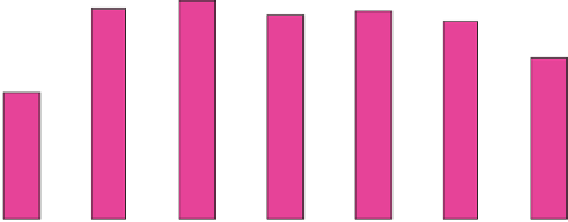Geology Reference
In-Depth Information
100
B
B
80
B
B
B
60
B
B
C
40
C
C
C
C
C
C
20
0
blades
stems
blades
stems
P. angustifolia
P. sinuosa
A. antarctica
A. griffithii
P. australis
Fig. 8.
Relative percentage of different
epiphyte taxa from each seagrass
species summarized from all sites.
C
B
Coralline algae
Bryozoans
Spirorbids
Benthic foraminifera
bivalves, 0.3%; serpulids, 0.2%; ostracods and
others <0.1%. Corallines have the highest abun-
dance at nearly every site (Fig. 8). Only corallines
show any geographic trend, decreasing northward
up Spencer Gulf.
Epiphytes on all seagrasses are dominated by cor-
allines 38.2-67.8% (Table 3 and Fig. 9), although
dominance on
A. antarctica
is least pronounced.
Amphibolis
stems show the highest proportion of
corallines (average 65.3%) and bryozoans (aver-
age 30.8%), but they have few other calcareous
epiphytes.
Posidonia sinuosa
has a relatively high
abundance of spirorbids and foraminifera in com-
parison to other
Posidonia
species (Fig. 8).
No differences are found for taxon abundance
with depth, water temperature or salinity using
in ANOVA and regression analysis. Nevertheless,
there are trends; corallines decrease with increasing
depth, salinity and temperature whereas bryozoans
increase with increasing depth, temperature and
salinity, but foraminifera show no change.
There are specifi c differences in the ratio
of calcareous epiphytes between seagrass
species. Corallines are relatively sparse on
A. antarctica
blades, bryozoans are numerous on
A. antarctica
stems, spirorbids are abundant
on
A. antarctica
and
P. sinuosa
, benthic fora-
minifera are high on
P. sinuosa
blades but low on
Amphibolis
stems and
A. griffi thii
blades (Fig. 8).
epiphytic carbonate and are present on 1523 of
the blades and stems analysed; thick encrusting
sheet (type 1
- Hydrolithon
sp.,
Pneophyllum
sp.,
Synarthrophyton
sp.) = 2.3%; encrusting sheet
(type 2 -
Hydrolithon
sp.,
Pneophyllum
sp.) =
68.7%; erect, thinly branching, fi lamentous (type
3 -
Jania
sp.) = 20.9%; erect, multiple branch-
ing, narrowly segmented (type 4 -
Corallina
sp.,
Arthocardia
sp.,
Jania
sp.,
Haliptilon
sp.) = 7.8%;
erect, simple branching, broadly segmented (type
5 -
Metagoniolithon radiatum
) = 0.3% (Table 4).
Encrusting forms produce 71.0% whereas rigid
branching and articulated branching forms
comprise 29.0%. This is the same for all except
A. antarctica
where erect narrow segmented
and thick encrusting algae are greater. The total
amount of carbonate produced ranges from <0.01
to 232 g kg
1
of grass.
Detailed study at West Island shows that 80% of
epiphytic carbonate on
Amphibolis
is associated
with the stems.
Amphibolis
stems and blades,
however, share similar epiphytic species, in par-
ticular geniculate corallines (e.g.
Pneophyllum-
Fosliella
group) (den Hartog, 1970; Ducker
et al
.,
1977; Sim, 1991). Temperature and light have
the greatest effect on growth rates of the coral-
lines (Bressan & Tomini, 1982; Jones & Woerkling,
1983), in particular
Fosliella cruciata
(a common
species on
A. antarctica
) does not germinate at
temperatures below 10°C.
There is a seasonal variation in epiphytes. A
decline in autumn/winter biomass is attributed
to a simultaneous decrease in seagrass biomass,
hence recruitment space, largely brought about by
Corallines
These algae (Fig. 10) are composed of magne-
sium calcite. They produce 38.2-67.8% of all


























































